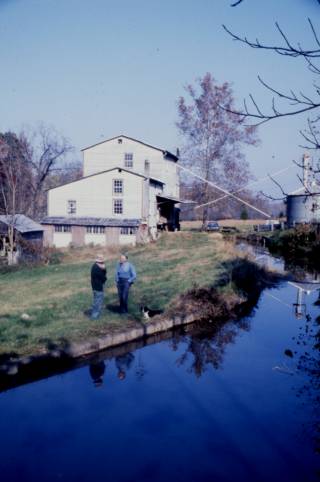
Naturalist Bill Hathaway, Tomahawk Mill Winery founder Walter Crider, and Crider's Border Collie, Tomahawk Virginia (“Ginny”) stand beside the Tomahawk Mill's race.
Winemaking is not new to Pittsylvania County, Virginia. According to a document recorded in deed book 63 at the courthouse in Chatham, plantation owner James M. Conway of Spring Garden and German-born rifle manufacturer Candidus Bilharz of Chatham entered into an agreement on Jan 8, 1869 to plant 5,000 grapevines for wine production, to be supervised by Bilharz, on an 800-acre farm known as “Cedar Hill.”
It is not known whether the contract was ever fulfulled. An 1878 map of Chatham shows a distillery operated by the Bolanz family (also German) located near Chatham's old ice plant at Chatham Hall's present-day entrance on Pruden Street. According to local tradition, the western slope of what is now the Chatham Hall campus was planted in grapes, the harvest of which was apparently used in Bolanz wines and brandies.
However, Pittsylvania County's vinter of the 1990's is Walter Crider of Tomahawk Mill Winery near Climax. Two years ago in March Crider planted his first grapevines. This month the first harvest is being picked and by February 200-300 bottles of Chardonnay should be available for sale to the public at the picturesque old gristmill-turned-winery.
Crider has Chardonnay and Johannisberg Riesling grapes, both white (actually pale green in color). The first harvest will only include Chardonnay. The Riesling grapes will not be ready until fall 1992. After harvest, the grapes will be pressed and the juice fermented, then allowed to rest. The result will be a dry table wine.
Crider's label for his bottles has been designed, and has met approvel by the Bureau of Alcohol, Tobacco and Firearms, the branch of the Department of Treasury that oversees such operations. The wine cellar at Tomahawk Mill Winery is unique. The circular grain bins from the gristmill's former days and identity have been insulated, air-conditioned, and floored with concrete, creating ideal climate-controlled wine storage space.
Crider, who retired from the Environmental Protection Agency several years ago to return to the gristmill built by his great-uncle, anticipates that his winery will become a tourist attraction because of the appeal of Virginia wine and the nostalgia of the old mill and pond. He plans to decorate the interior with enlargements of professional wildflower photographs, which will be available for sale.
Crider is optimistic that the wines, to contain 11 percent alcohol, will be well-received. He has chosen and cultivated the best plants available, and will use modern instruments and techniques to assure a good product. He and others knowledgeable about wines will taste-test the vintage, and as Crider points out, “80 percent of the quality of wine is in the grapes.”
Copyright © 1990–2006 Patricia B. Mitchell.